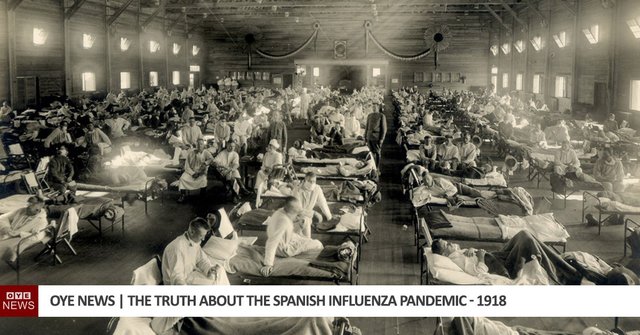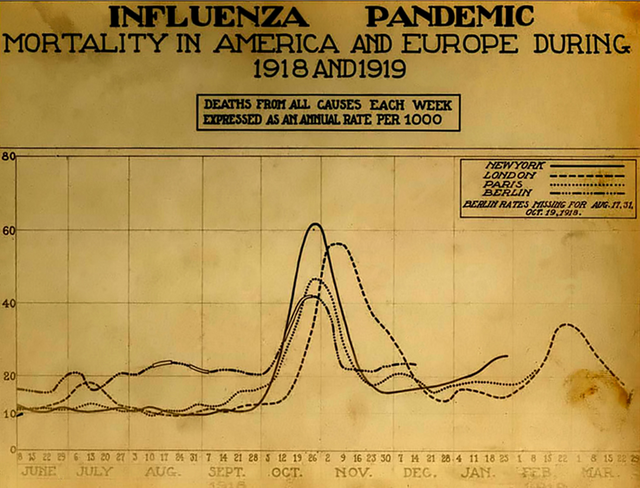The Truth About the Spanish Influenza Pandemic - 1918

It's often useful to not only dig into the facts behind current events but also take a look back in time to well known legendary events, such as the 1918 Spanish Influenza epidemic which the history books claim took the lives of between 50 and 100 million people worldwide. Lets begin!
Wave 1 - Spanish Influenza (H1N1)
The Spanish influenza pandemic began in early 1918, while we dont know for sure the first case many believe patient zero was possibly Albert Gitchell who reported sick with a fever of 104º Fahrenheit at Camp Funston, part of Fort Riley, where 54,000 men were gathered for basic training.
Just days later, 522 soldiers reported sick and by the end of the month, 1,100 soldiers were admitted to hospital with influenza.
Now here is where things begin to get interesting. The initial phase of the virus was being described as a mild virus which commonly results in a 3-day fever and full recovery. A small number of patients suffered complications, typically pneumonia that led to fatalities. In fact, by June 1918 the number of cases in Europe and North America began to steadily decline which led to the belief that the flu pandemic was over.
Wave 2 - Return of the Virus, or Something Else?
In late August 1918 what appeared to be a reemergence of the virus struck the World, but this time something was different, unlike in the first outbreak where the affects of the virus were being considered relatively mild with few complications, this time the mortality rate blew up into something truly terrifying.
Millions of people were dying, in fact it is estimated that anywhere between 50 - 100 Million people had died by the end of the following year.
The influenza virus itself wasn't initially thaught to be anymore dangerous than previous strains of the virus, the first bout of the virus outbreaks in early 1918 didn't really raise alarm bells for what was to come. So the question is, what changed, why did the mortality rate spike so rapidly towards the end of 1918 when wave 2 hit?

Chart showing mortality from the 1918 influenza pandemic in the US and Europe
What are Salicylates?
Salicylate is a salt or ester of salicylic acid. Salicylates are found naturally in some plants (such as white willow bark and wintergreen leaves) and are thought to protect the plant against insect damage and disease. Aspirin is a derivative of salicylic acid - and is also known as acetylsalicylic acid. [Source]
Compared to foods aspirin contains high amounts of salicylates, which is why salicylate intolerance is most commonly linked to medications. For example, dietary intake of salicylates is usually 10–200 mg per day.
In 2009 a study by Karen M. Starko looked at whether the unusually high mortality rates of the spanish influenza, paticulary in Wave 2 could be attributed to the over prescription of Salicylates, in paticular Asprin.
Here are her notes from the Studies opening paragraph:
The high case-fatality rate—especially among young adults—during the 1918–1919 influenza pandemic is incompletely understood. Although late deaths showed bacterial pneumonia, early deaths exhibited extremely “wet,” sometimes hemorrhagic lungs. The hypothesis presented herein is that aspirin contributed to the incidence and severity of viral pathology, bacterial infection, and death, because physicians of the day were unaware that the regimens (8.0–31.2 g per day) produce levels associated with hyperventilation and pulmonary edema in 33% and 3% of recipients, respectively. Recently, pulmonary edema was found at autopsy in 46% of 26 salicylate-intoxicated adults. Experimentally, salicylates increase lung fluid and protein levels and impair mucociliary clearance. In 1918, the US Surgeon General, the US Navy, and the Journal of the American Medical Association recommended use of aspirin just before the October death spike. If these recommendations were followed, and if pulmonary edema occurred in 3% of persons, a significant proportion of the deaths may be attributable to aspirin.
There is a lot of research that concludes the occurrence of pulmonary edema in humans with salicylate intoxication, and just we are clear - salicylates were being recommended with little guidance and in large doses.
So what do we find when performing an autopsy on a patient who died from asprin Toxicity, lets take a look:
A study of 177 adults with aspirin toxicity (and a 15% mortality rate) found the most common presentations were depressed consciousness (61%) and respiratory failure (47%), even “at therapeutic levels”.
Autopsy findings for patients with the 26 fatal cases were pulmonary edema (46%), ulcers (46%), cerebral hemorrhage (23%), and cerebral edema (31%). Coagulation disturbance or thrombocytopenia was found in 38%.
A detailed autopsy of an adult with aspirin poisoning revealed cyanosis, pulmonary congestion, alveolar hemorrhage, subpleural and subepicardial hemorrhages, petechiae, cloudy swelling of the kidneys, and fatty degeneration of the liver .
ARDS-like disease has also been reported.
Children with aspirin toxicity (or Reye syndrome) are less likely than adults to present with pulmonary edema, although in addition to brain swelling, fatty liver, and cloudy swelling of the kidneys, some have pulmonary edema, “frothy, blood-tinged fluid” , and lung hemorrhages. [source]
Now how do these findings compare to the autopsy findings of victims of the Spanish Flu back in 1918:
Autopsy reports by pathologists of the day describe extremely wet, sometimes hemorrhagic lungs in early deaths. On 23 September 1918 at Camp Devens in Massachusetts, 12,604 soldiers had influenza, and 727 had pneumonia; after examining the lungs of a dead soldier, Colonel Welch concluded, “This must be some new kind of infection or plague”.
What struck E. R. Le Count, consulting pathologist to the US Public Health Service, as most unusual was the amount of lung tissue actually “pneumonic” seemed “too little in many cases to explain death by pneumonia.”
He saw a thin, watery, bloody liquid in the lung tissue, “like the lungs of the drowned,” as well as pleural exudates with small hemorrhages unlike those seen in “any other form of acute pneumonia of which I am familiar.” Importantly, he also noted the brain was “quite regularly swollen,” the kidneys were “regularly the seat of cloudy swelling,” and the liver had “superficial fatty change,”
Brain weight was increased by 100–200 g in ∼50% of persons, most likely indicating cerebral edema; cerebral bleeding was common. Wolbach, chief pathologist at the Peter Bent Brigham Hospital in Boston, Massachusetts, found bacterial infection in late deaths, yet a person dying on day 2 exhibited edema and congestion of the lung, a purpuric rash, and no bacterial growth.
He surmised a natural progression from the early lesion to the bacterial lesions: “Two types of lungs stand out.” In early deaths, the lungs were “dark red and wet…dripping wet.” [source]
A report from Camp Dix noted:
“The disease was a veritable plague. The extraordinary toxicity, the marked prostration, the extreme cyanosis and the rapidity of development stamp this disease as a distinct clinical entity heretofore not fully described.…Pneumonia is an important but somewhat secondary factor”
Back in 1918, differentiating progressive salicylate intoxication from infection pathologically or clinically, was almost impossible:
"The dyspnea lasts from a few hours to a day…followed by respiratory failure, circulatory collapse, convulsions, and death"
According to research uncovered by F. William Engdahl people were killed by common bacteria found in the upper respiratory tract:
“The 20 to 40 million deaths worldwide from the great 1918 Influenza Pandemic were NOT due to ‘flu’ or a virus, but to pneumonia caused by massive bacterial infection.”
September 1918 Asprin Recommendation
When the virus appeared to be making a resurgance in August of 1918 health authorities made an official reccomendation on the use of Asprin for those suffering with the virus.
Official recommendations for aspirin were issued on 13 September 1918 by the US Surgeon General, who stated aspirin had been used in foreign countries “with much success in the relief of symptoms". Recommendations often suggested dose regimens that predispose to toxicity as noted above.
“I did not lose a single case of influenza; my death rate in the pneumonias was 2.1%. The salycilates, including aspirin and quinine, were almost the sole standbys of the old school and it was a common thing to hear them speaking of losing 60% of their pneumonias.”
~Dudley A. Williams, MD, Providence, Rhode Island.
“There is one drug which directly or indirectly was the cause of the loss of more lives than was influenza itself. You all know that drug. It claims to be salicylic acid. Aspirin’s history has been printed. Today you don’t know what the sedative action of salicylic acid is. It did harm in two ways. It’s indirect action came through the fact that aspirin was taken until prostration resulted and the patient developed pneumonia.”
~Frank L. Newton, MD, Somerville, Massachusetts
“Three hundred and fifty cases and lost one, a neglected pneumonia that came to me after she had taken one hundred grains of aspirin in twenty-four hours.”
~Cora Smith King, MD, Washington, DC
Asprin became the most demanded pharmacutical on earth, dosages were relatively non-specific and it was not uncommon for hourly dosages of several thousands of mg's to be administered to patients hospitalised and those at home.
Why the Coverup?
Well most likely the important role asprin played in the high mortlaity rate of the virus has been underplayed and to a degree dismissed as the epidemic led to the authourtarian health system we have today. It also birthed the beginning of the push for vaccines to ensure such pandemics would not happen again.
Of course if we could attribute a large proportion of the deaths from the Spanish Influenza to Asprin, the very medicine that was being prescribed, then we loose yet another historical event to place the fear into people today over the necessity of vaccines, and the corrupt health authourities that have taken over our health.
The Perfect Storm
The following video is an excellent explanation of just how this perfect storm occurred prior to the Spanish Influenze pandemic.
History Repeats
While it is far more likely that the events of the 1918 Spanish Influenza pandemic were more down to lack of real knowledge surrounding the affects of Asprin when taken in large doses, compounded with the perfect storm of events which preceeded 1918 following WWI - there is still lessons to be learnt when considering whats going on with the recent outbreak of the Coronavirus.
We must understand that our health is by far the best chance you can give yourself when facing any viral infection.
Originally published on our website over at OYE NEWS : https://www.oye.news/news/health/the-truth-about-the-spanish-influenza-pandemic-1918/